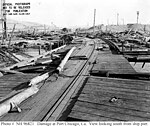Roe Island

Roe Island is an island in Suisun Bay at the mouth of the Sacramento-San Joaquin River Delta in Solano County, California, 10 km east of Benicia. Its western tip is named Preston Point, and its eastern tip is Gillespie Point. It is shown, labeled "Preston Island", on an 1850 survey map of the San Francisco Bay area made by Cadwalader Ringgold and an 1854 map of the area by Henry Lange. It is labeled, along with Deadman Island, Joice Island, Grizzly Island, Simmons Island and Ryer Island, on a 1902 USGS map of the area.On November 22, 2010, Brian Hopper was rescued from Roe Island by the U.S. Coast Guard. He had been stranded on the island for five days (after his rubber raft sprung a leak), before using his cell phone to contact a cousin, who notified the Coast Guard.
Excerpt from the Wikipedia article Roe Island (License: CC BY-SA 3.0, Authors, Images).Roe Island
Geographical coordinates (GPS) Address Nearby Places Show on map
Geographical coordinates (GPS)
| Latitude | Longitude |
|---|---|
| N 38.0725 ° | E -122.03472222222 ° |
Address
Solano County (Solano)
California, United States
Open on Google Maps








